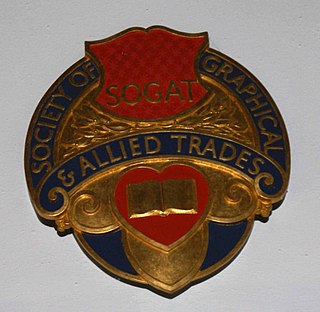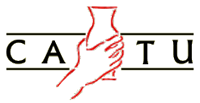
The Graphical, Paper and Media Union (GPMU) was a trade union in the United Kingdom and Ireland between 1991 and 2005.

The Society of Graphical and Allied Trades (SOGAT) was a British trade union in the printing industry.

The National Graphical Association (NGA) was a trade union representing typographers and related workers in the United Kingdom.

The Ceramic and Allied Trades Union (CATU) was a trade union representing pottery workers in the United Kingdom.

The Modern Records Centre (MRC) is the specialist archive service of the University of Warwick in Coventry, England, located adjacent to the Central Campus Library. It was established in October 1973 and holds the world's largest archive collection on British industrial relations, as well as archives relating to many other aspects of British social, political and economic history.

The Amalgamated Lithographers of America (ALA) is a labor union formed in 1915 to conduct collective bargaining on behalf of workers in the craft of lithography. The ALA was established through the amalgamation of several small unions already existing in the lithographic industry, one of which dated back to 1886.
The London Society of Compositors was a British trade union, representing print workers in London.
The Printing and Kindred Industries Union (PKIU) was an Australian trade union which existed between 1966 and 1995. It represented production workers in the printing industry, including compositing, typesetting, letterpress printing, lithographic plate-making, electrotyping, stereotyping and bookbinding, and the manufacture of paper and cardboard products, such as paper bags, envelopes, cardboard boxes and cartons. Approximately half of all members were qualified tradespeople, with the remainder semi-skilled or unskilled workers.
The Amalgamated Society of Lithographic Printers (ASLP) was a trade union representing printers and their assistants in the United Kingdom and Ireland.
The British Steel Smelters' Association (BSSA) was a trade union representing steel smelters and workers in related trades in Britain.
The National Union of Textile Workers was a trade union representing workers in the textile industry in England, principally in Yorkshire.

The Amalgamated Society of Dyers, Finishers and Kindred Trades was a trade union representing dyers and workers in related jobs in the United Kingdom.
The National Union of Wallcoverings, Decorative and Allied Trades (NUWDAT) was an industrial union representing workers connected with the manufacture of wallpaper in the United Kingdom.

The Printing and Kindred Trades Federation (P&KTF) was a trade union federation in the United Kingdom.
The Irish Graphical Society was a trade union representing workers in the printing trades in Dublin.
The Blackburn and District Weavers' Winders' and Warpers' Association was a trade union representing cotton industry workers in Blackburn, Lancashire, in England. One of the earliest weavers' unions to endure, it formed a model that many others copied, and was at the centre of early attempts to form a regional federation of cotton trade unions.
The United Society of Engravers was a trade union representing engravers, principally in the cotton industry, but also in the paper printing industry, in the United Kingdom.
The National Society of Electrotypers and Stereotypers (NSES) was a trade union representing workers in print foundries in the United Kingdom.
John Jackson was a British trade unionist, who became the leader of one of the country's print unions.
Tony Burke was a British full time trade union official in the print unions, the NGA and GPMU, Amicus and retired in 2022 as an Assistant General Secretary of Unite the Union in the UK and Ireland.









